Marc Tyler Nobleman's Blog, page 135
March 12, 2012
Evolution of my school visit "shlep list"
On occasion, a host at one of my school visits gets a panicked look when s/he sees what I bring for my presentation. Rather than come right out with what that is, I'll trace the evolution, for fuller effect:
2004
portable whiteboard to draw on, plus the marker and eraserslide projector (you read that right; more below)
the slidessmall drawing to tape to the bottom of one of the students' chairs before they enter the room; at the end of the presentation, I ask them to check for it to determine which student will randomly win a copy of one of my booksthe tape
the book to randomly give out
my presentation outline
handouts:
I don't know why I thought the schools wouldn't have a whiteboard, and a much bigger one at that.
Well past the ubiquity of PowerPoint, I really did buy a used slide projector on eBay. Though I expected to spend no more than $5, mine cost $68. I carried it in one of those familiar, cavernous IKEA bags:
 It was especially annoying to lug around when it was raining. Once I left it in the car overnight before a visit and it was so cold out that once inside the school it took 20 minutes for it to "thaw."
It was especially annoying to lug around when it was raining. Once I left it in the car overnight before a visit and it was so cold out that once inside the school it took 20 minutes for it to "thaw."
The slides were more expensive than the projector.
If the kids sat on the floor instead of chairs, I'd tape the small drawing to one of their rears. Do not believe that.
2007
I finally began using PowerPoint, reselling my slide projector on eBay (for a loss at $44) and adopting the infinitely more portable flash drive. I had been postponing making this switch because I was worried that it would be complicated to make my first PowerPoint; I ended up throwing it together during one hourlong nap of my toddler daughter.
2008
I stopped distributing forms and instead e-mailed versions of them. Soon I would stop doing this as well, hoping word of mouth would ignite even without the thrill of paperwork.
2010
I was no longer referring to my text outline while speaking; by now I referred only to a printout of the slide show, and even then only occasionally. Soon, for my standard presentation, I would stop using notes altogether.
2012
I now show up with just a flash drive in my pocket, sometimes my camera in another pocket (though I often slum it with my iPhone camera instead), and sometimes some of the last of the Boys of Steel: The Creators of Superman postcards. At times I also bring a giveaway. And at times, upon noticing upon my arrival that I have no props, my host gets that slightly alarmed (though fleeting) look I teased about at the top of this post.
I can't help but smile when I think back to my heavy loads in the early days, especially when I now jaunt into schools encumbered only by this:


2004
portable whiteboard to draw on, plus the marker and eraserslide projector (you read that right; more below)
the slidessmall drawing to tape to the bottom of one of the students' chairs before they enter the room; at the end of the presentation, I ask them to check for it to determine which student will randomly win a copy of one of my booksthe tape
the book to randomly give out
my presentation outline
handouts:
feedback form to be copied and distributed to studentsfeedback form to be copied and distributed to teachersreferral form (to fax to other schools; probably no one ever used it)list of publications that publish work by young people (to be distributed to students)notes:
I don't know why I thought the schools wouldn't have a whiteboard, and a much bigger one at that.
Well past the ubiquity of PowerPoint, I really did buy a used slide projector on eBay. Though I expected to spend no more than $5, mine cost $68. I carried it in one of those familiar, cavernous IKEA bags:
 It was especially annoying to lug around when it was raining. Once I left it in the car overnight before a visit and it was so cold out that once inside the school it took 20 minutes for it to "thaw."
It was especially annoying to lug around when it was raining. Once I left it in the car overnight before a visit and it was so cold out that once inside the school it took 20 minutes for it to "thaw."The slides were more expensive than the projector.
If the kids sat on the floor instead of chairs, I'd tape the small drawing to one of their rears. Do not believe that.
2007
I finally began using PowerPoint, reselling my slide projector on eBay (for a loss at $44) and adopting the infinitely more portable flash drive. I had been postponing making this switch because I was worried that it would be complicated to make my first PowerPoint; I ended up throwing it together during one hourlong nap of my toddler daughter.
2008
I stopped distributing forms and instead e-mailed versions of them. Soon I would stop doing this as well, hoping word of mouth would ignite even without the thrill of paperwork.
2010
I was no longer referring to my text outline while speaking; by now I referred only to a printout of the slide show, and even then only occasionally. Soon, for my standard presentation, I would stop using notes altogether.
2012
I now show up with just a flash drive in my pocket, sometimes my camera in another pocket (though I often slum it with my iPhone camera instead), and sometimes some of the last of the Boys of Steel: The Creators of Superman postcards. At times I also bring a giveaway. And at times, upon noticing upon my arrival that I have no props, my host gets that slightly alarmed (though fleeting) look I teased about at the top of this post.
I can't help but smile when I think back to my heavy loads in the early days, especially when I now jaunt into schools encumbered only by this:

Published on March 12, 2012 03:58
February 22, 2012
Batman and Robin gay? Bill Finger said...
In the controversial 1954 book Seduction of the Innocent, psychiatrist Fredric Wertham claimed that Batman and Robin were gay and that their comic book stories were (perhaps subconsciously) promoting a homosexual lifestyle.
In 1972, Bill Finger, uncredited co-creator of Batman and Robin, gave an interview that remained lost until 2008 and unpublished until 2011; in that interview, to my great surprise, Bill was asked about the sexual orientation issue. Here is his response:

In 1972, Bill Finger, uncredited co-creator of Batman and Robin, gave an interview that remained lost until 2008 and unpublished until 2011; in that interview, to my great surprise, Bill was asked about the sexual orientation issue. Here is his response:
What about his claim that Batman and Robin were homosexual fantasies?
I knew many homosexuals but I certainly didn't think of Batman in those terms. I thought of it in terms of … Frank Merriwell and Dick Merriwell, his half-brother, who was the kid he was taking care of. … In America we always talk about the Western hero and the pioneer kind of man—the Davy Crockett types—as being loners. They're never really. They always have a sidekick. … Certainly there's no homosexual relationship. It's just part of the American syndrome. … It was just that the author realized that you've gotta have somebody to talk to. Sherlock Holmes had Watson—were they homosexuals? Baloney. You just can't have your hero walking around thinking aloud all the time. He'd be ready for the men in white coats after a time. So we created a junior Watson and that's all [Robin] was.
Published on February 22, 2012 04:55
February 20, 2012
Interview at Author Turf
Brittney Breakey at Author Turf interviewed me and included my favorite kind of question: one I haven't been asked before. Three examples:
What element would you add to your writing space if money wasn't an issue?
Easier to write before or after you were published?
What's one rule you're dying to break?
And here's an excerpt:

What element would you add to your writing space if money wasn't an issue?
Easier to write before or after you were published?
What's one rule you're dying to break?
And here's an excerpt:
The work is done. How do you recharge?
The work is never done! But if I allow myself a break, I love to go for a run while listening to music. Running and writing go well together—both solitary, both invigorating, both something we all start to learn to do from a young age but can refine with practice.
Published on February 20, 2012 13:55
February 19, 2012
Best of the blog 2011
This blog launched on 2/19/08.
Every February 19 (starting this year), I will share what I feel have been the best posts of the previous year (so saying it's the best of 2011 is a slight fudge since it doesn't include January and part of February 2011 and does include January and part of February 2012...you get it).
Without further hullabaloo:
research
the building in which Batman was (most likely) createdwhy didn't Bill Finger (co-creator of Batman) serve in WWII?
Every February 19 (starting this year), I will share what I feel have been the best posts of the previous year (so saying it's the best of 2011 is a slight fudge since it doesn't include January and part of February 2011 and does include January and part of February 2012...you get it).
Without further hullabaloo:
research
the building in which Batman was (most likely) createdwhy didn't Bill Finger (co-creator of Batman) serve in WWII?
Published on February 19, 2012 04:21
February 13, 2012
The Batman Encyclopedia
In recent times, superhero universes and the most popular solo characters (Superman; Batman; Wonder Woman; even a villain, the Joker) have been the focus of their own encyclopedias.
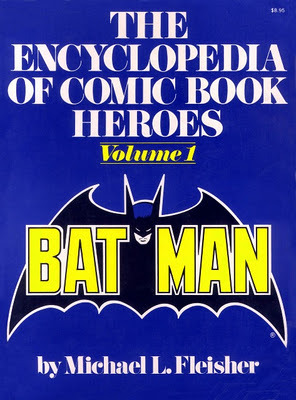
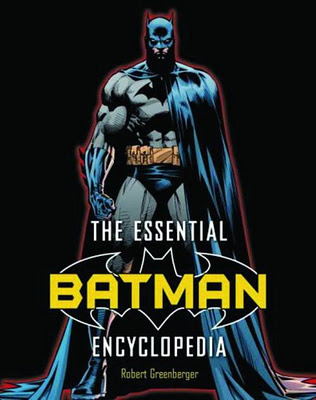
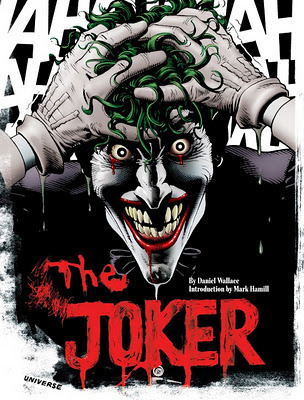 In our superhero-saturated modern culture, that is not so surprising.
In our superhero-saturated modern culture, that is not so surprising.
However, in 1954, as was something of a pattern, Bill Finger had the idea first.
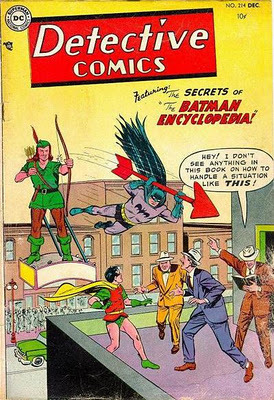



 In our superhero-saturated modern culture, that is not so surprising.
In our superhero-saturated modern culture, that is not so surprising. However, in 1954, as was something of a pattern, Bill Finger had the idea first.

Published on February 13, 2012 04:29
February 8, 2012
Bill Finger named co-creator in DC Comics publications
Happy (what would've been your) 98th birthday, Bill.
My gift: credit, in the form of the following list of statements acknowledging you as co-creator of Batman. All statements were either published by DC Comics or said by a DC Comics associate in good standing.
"Now that my long-time friend and collaborator is gone, I must admit that Bill never received the fame and recognition he deserved. He was an unsung hero. … I often tell my wife, if I could go back fifteen years, before he died, I would like to say, 'I'll put your name on it now. You deserve it.'"
—Bob Kane, Batman and Me (1989), page 44
"The Darknight Detective debuted in #27, the creation of Bob Kane and Bill Finger"
—Paul Levitz, DC Comics President 2002-2009, Detective Comics #500 (published by DC Comics, 1981), inside back cover
"Kane, along with writer Bill Finger, had just created Batman for National Comics, the company that would eventually become DC Comics."
—DC Comics press release "DC Comics Names Legendary Batman Artist Jerry Robinson Creative Consultant," 10/26/07
"Last February, The Batman lost a father. One of his two real fathers, that is. …his chief fame will always rest on his co-creation of the Batman legend."
—Carmine Infantino, DC Comics Publisher 1971-1976 (during which time Finger died), Famous 1st Edition: Batman #1 (published by DC Comics, 1974), inside front cover
"Bob Kane and Bill Finger combined to produce a character that fit right into the Detective Comics bag, but changed the entire direction of the magazine and of the comics industry itself."
—uncredited editorial, World's Finest #184 (published by DC Comics, 1969)
"…Bob was only 23 when he and collaborator Bill Finger sat on a bench outside of Edgar Allan Poe's house and talked about a different kind of comic character"; also refers to Finger as Bob's "most important collaborator" and details some of the iconic aspects that Bill alone contributed
—Jenette Kahn, DC Comics President and Editor-in-Chief 1976-2002, "Bob Kane 1915-1998," published in DC Comics titles
"…best scripter in the business and the true cocreator of Batman"
—Julius Schwartz, DC Comics editor 1944-1986 and Editor Emeritus 1986-2004, Man of Two Worlds (2000), page 155
"I'm glad somebody's writing about him. You ought to call it The Father of Batman. You wouldn't be wrong."
—Carmine Infantino, personal interview 2006
"It was such a great creative effort by so many people over so many decades that really 'created' Batman. But you still have to look at Bill Finger as one of the two essentials. It's Kane-and-Finger—and I say that in one breath—who were there at the beginning."
—Michael Uslan, producer of the Batman movies and close friend of Kane's, "Unmasking Batman," Wizard #135 (12/02), pages 88, 90
"The Bill Finger Award for Excellence in Comic Book Writing falls under the auspices of Comic-Con International … The [first annual] 2005 awards are being underwritten by DC Comics … Bill Finger (1914-1974), the unsung hero and co-creator of Batman, scripted the first and many of the best Batman stories during the Golden Age of comic books. He created many of the series' most notable characters, including the Penguin, Riddler, Catwoman, and Two-Face, and he made significant refinements to Batman's concept and persona. Finger wrote the scripts that introduced the Bat Cave, Batmobile, Batplane, and Batsignal. Many terms he created, such as the Dynamic Duo and Gotham City, have become part of our lexicon."
—from the official site of Comic-Con International
"Created by Bob Kane in collaboration with writer Bill Finger…"
—Batman: The Dark Knight Archives, Volume 2 (published by DC Comics, 1995), inside front flap
"Bill Finger was one of the true innovative talents and legendary figures of the comic industry … He collaborated with Kane on the development of Batman…"
—Batman in the Sixties (published by DC Comics, 1999)
"There was Bob Kane, 22 years old in May of 1939, and Bill Finger …Kane produced the art … Finger wrote the scripts. … So Kane and Finger fashioned something old, something new in the Batman."
—Rich Marschall, Batman Archives, Volume 1 (published by DC Comics, 1990), Foreword, page 4
In Fifty Who Made DC Great (published by DC Comics, 1985), Bob Kane and Bill Finger biographies are side-by-side. Kane's subtitle is "Batman Takes Wing." Finger's is "The Darknight Detective Emerges." Neither is described as "creator" or "co-creator."
Batman: The Complete History (published with DC Comics, 1999) introduces Kane and Finger on the first page in equal measure, never stating Kane alone is the creator
"He…laid the groundwork for a legend."
—Batman in the Seventies (published by DC Comics, 2000), memoriam to Bill Finger
"[Bob Kane and Bill Finger] co-created the feature and Bill wrote it."
—Jerry Robinson, one of the first people besides Kane or Finger to work on Batman, joined the strip the year of its debut, in the 1970s was the driving force in convincing DC Comics to give Jerry Siegel and Joe Shuster credit and money for Superman, named a DC Creative Consultant 2007, The Comics Journal #271 (2005), page 80
"Bill Finger deserves co-credit for the creation of Batman, simple as that."
—Jerry Robinson, "Unmasking Batman," Wizard #135 (12/02), page 90
See also: Bill Finger, the Superlative Man.

My gift: credit, in the form of the following list of statements acknowledging you as co-creator of Batman. All statements were either published by DC Comics or said by a DC Comics associate in good standing.
"Now that my long-time friend and collaborator is gone, I must admit that Bill never received the fame and recognition he deserved. He was an unsung hero. … I often tell my wife, if I could go back fifteen years, before he died, I would like to say, 'I'll put your name on it now. You deserve it.'"
—Bob Kane, Batman and Me (1989), page 44
"The Darknight Detective debuted in #27, the creation of Bob Kane and Bill Finger"
—Paul Levitz, DC Comics President 2002-2009, Detective Comics #500 (published by DC Comics, 1981), inside back cover
"Kane, along with writer Bill Finger, had just created Batman for National Comics, the company that would eventually become DC Comics."
—DC Comics press release "DC Comics Names Legendary Batman Artist Jerry Robinson Creative Consultant," 10/26/07
"Last February, The Batman lost a father. One of his two real fathers, that is. …his chief fame will always rest on his co-creation of the Batman legend."
—Carmine Infantino, DC Comics Publisher 1971-1976 (during which time Finger died), Famous 1st Edition: Batman #1 (published by DC Comics, 1974), inside front cover
"Bob Kane and Bill Finger combined to produce a character that fit right into the Detective Comics bag, but changed the entire direction of the magazine and of the comics industry itself."
—uncredited editorial, World's Finest #184 (published by DC Comics, 1969)
"…Bob was only 23 when he and collaborator Bill Finger sat on a bench outside of Edgar Allan Poe's house and talked about a different kind of comic character"; also refers to Finger as Bob's "most important collaborator" and details some of the iconic aspects that Bill alone contributed
—Jenette Kahn, DC Comics President and Editor-in-Chief 1976-2002, "Bob Kane 1915-1998," published in DC Comics titles
"…best scripter in the business and the true cocreator of Batman"
—Julius Schwartz, DC Comics editor 1944-1986 and Editor Emeritus 1986-2004, Man of Two Worlds (2000), page 155
"I'm glad somebody's writing about him. You ought to call it The Father of Batman. You wouldn't be wrong."
—Carmine Infantino, personal interview 2006
"It was such a great creative effort by so many people over so many decades that really 'created' Batman. But you still have to look at Bill Finger as one of the two essentials. It's Kane-and-Finger—and I say that in one breath—who were there at the beginning."
—Michael Uslan, producer of the Batman movies and close friend of Kane's, "Unmasking Batman," Wizard #135 (12/02), pages 88, 90
"The Bill Finger Award for Excellence in Comic Book Writing falls under the auspices of Comic-Con International … The [first annual] 2005 awards are being underwritten by DC Comics … Bill Finger (1914-1974), the unsung hero and co-creator of Batman, scripted the first and many of the best Batman stories during the Golden Age of comic books. He created many of the series' most notable characters, including the Penguin, Riddler, Catwoman, and Two-Face, and he made significant refinements to Batman's concept and persona. Finger wrote the scripts that introduced the Bat Cave, Batmobile, Batplane, and Batsignal. Many terms he created, such as the Dynamic Duo and Gotham City, have become part of our lexicon."
—from the official site of Comic-Con International
"Created by Bob Kane in collaboration with writer Bill Finger…"
—Batman: The Dark Knight Archives, Volume 2 (published by DC Comics, 1995), inside front flap
"Bill Finger was one of the true innovative talents and legendary figures of the comic industry … He collaborated with Kane on the development of Batman…"
—Batman in the Sixties (published by DC Comics, 1999)
"There was Bob Kane, 22 years old in May of 1939, and Bill Finger …Kane produced the art … Finger wrote the scripts. … So Kane and Finger fashioned something old, something new in the Batman."
—Rich Marschall, Batman Archives, Volume 1 (published by DC Comics, 1990), Foreword, page 4
In Fifty Who Made DC Great (published by DC Comics, 1985), Bob Kane and Bill Finger biographies are side-by-side. Kane's subtitle is "Batman Takes Wing." Finger's is "The Darknight Detective Emerges." Neither is described as "creator" or "co-creator."
Batman: The Complete History (published with DC Comics, 1999) introduces Kane and Finger on the first page in equal measure, never stating Kane alone is the creator
"He…laid the groundwork for a legend."
—Batman in the Seventies (published by DC Comics, 2000), memoriam to Bill Finger
"[Bob Kane and Bill Finger] co-created the feature and Bill wrote it."
—Jerry Robinson, one of the first people besides Kane or Finger to work on Batman, joined the strip the year of its debut, in the 1970s was the driving force in convincing DC Comics to give Jerry Siegel and Joe Shuster credit and money for Superman, named a DC Creative Consultant 2007, The Comics Journal #271 (2005), page 80
"Bill Finger deserves co-credit for the creation of Batman, simple as that."
—Jerry Robinson, "Unmasking Batman," Wizard #135 (12/02), page 90
See also: Bill Finger, the Superlative Man.
Published on February 08, 2012 04:20
February 3, 2012
School visit snafus
One author. Hundreds of kids. Sometimes remote locations. Computer equipment. Slippery cafeteria floors.
What could go wrong?
A few of the possible mishaps an author might encounter (I mean "an author sometime somewhere has encountered") on the circuit:
PowerPoint equipment set up upon arrival, but not workingPowerPoint equipment not set up upon arrivalPowerPoint equipment not present at allPowerPoint equipment set up in middle of sea of students sitting on floor, but no remote (meaning you must meander through the kids to change each slide)No microphone with a big groupNo microphone with a small groupMicrophone battery conks out mid-presentationLCD projector bulb burns out mid-presentationPower goes out mid-presentationCeiling tile plummets to the floor mid-presentation (this has really happened to me; luckily and amazingly, it didn't hit anyone)
Principal not told there would be a presentationTeachers not told there would be a presentationStudents told there would be a presentation but were expecting someone way more famous than you
Classroom teachers don't remain with students during presentationPresentation scheduled during students' usual lunch periodPresentation scheduled immediately after gym or recess of kids of pre-deodorant age
Presentation in room next to a loud activity (such as band practice)People regularly coming in and out of the room during the presentation—and letting door slam each timePresentation in gym and basketball hoop blocking screen (this has really happened to me; it actually took some work for me to convince the organizer to raise it)
School changes audience make-up in an impractical way without giving you warning (such as grouping kindergartners with sixth graders)Accidentally saying a word you shouldn't in front of the kids (this happened only once to me and the word wasn't so bad that I felt guilty when it slipped out)No available parking space in school lotForgetting flash drive in school computer when leaving
Forgetting flash drive at home
Leaving the same time the buses are so you get trapped behind them for 30 minutes
Authors—please add to the list in the comments.
All of this is said with affection. None of this—even all of this—is enough to deter me from continuing to do as many school visits as possible. It is one the greatest joys and perks and privileges of my job.
Everything worthwhile involves a challenge at some point. And most things at one time frustrating become funny in hindsight.

What could go wrong?
A few of the possible mishaps an author might encounter (I mean "an author sometime somewhere has encountered") on the circuit:
PowerPoint equipment set up upon arrival, but not workingPowerPoint equipment not set up upon arrivalPowerPoint equipment not present at allPowerPoint equipment set up in middle of sea of students sitting on floor, but no remote (meaning you must meander through the kids to change each slide)No microphone with a big groupNo microphone with a small groupMicrophone battery conks out mid-presentationLCD projector bulb burns out mid-presentationPower goes out mid-presentationCeiling tile plummets to the floor mid-presentation (this has really happened to me; luckily and amazingly, it didn't hit anyone)
Principal not told there would be a presentationTeachers not told there would be a presentationStudents told there would be a presentation but were expecting someone way more famous than you
Classroom teachers don't remain with students during presentationPresentation scheduled during students' usual lunch periodPresentation scheduled immediately after gym or recess of kids of pre-deodorant age
Presentation in room next to a loud activity (such as band practice)People regularly coming in and out of the room during the presentation—and letting door slam each timePresentation in gym and basketball hoop blocking screen (this has really happened to me; it actually took some work for me to convince the organizer to raise it)
School changes audience make-up in an impractical way without giving you warning (such as grouping kindergartners with sixth graders)Accidentally saying a word you shouldn't in front of the kids (this happened only once to me and the word wasn't so bad that I felt guilty when it slipped out)No available parking space in school lotForgetting flash drive in school computer when leaving
Forgetting flash drive at home
Leaving the same time the buses are so you get trapped behind them for 30 minutes
Authors—please add to the list in the comments.
All of this is said with affection. None of this—even all of this—is enough to deter me from continuing to do as many school visits as possible. It is one the greatest joys and perks and privileges of my job.
Everything worthwhile involves a challenge at some point. And most things at one time frustrating become funny in hindsight.
Published on February 03, 2012 04:45
February 1, 2012
A 365 180°
The store brand for natural foods juggernaut Whole Foods is called 365.
 So naturally, I pitched them my book 365 Things to Do Before You Grow Up.
So naturally, I pitched them my book 365 Things to Do Before You Grow Up.
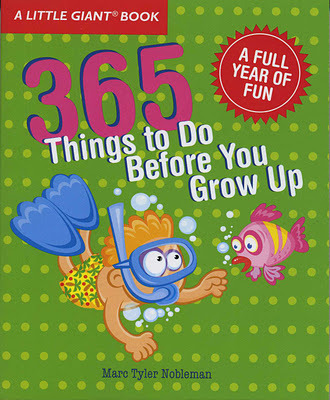 While waiting to hear from Whole Foods, I tweaked the pitch for Wegmans (whose store brand is called Wegmans).
While waiting to hear from Whole Foods, I tweaked the pitch for Wegmans (whose store brand is called Wegmans).
And it was Wegmans, not the expected Whole Foods, that ultimately carried the book. (Actually, Whole Foods has not formally said no.)

 So naturally, I pitched them my book 365 Things to Do Before You Grow Up.
So naturally, I pitched them my book 365 Things to Do Before You Grow Up. While waiting to hear from Whole Foods, I tweaked the pitch for Wegmans (whose store brand is called Wegmans).
While waiting to hear from Whole Foods, I tweaked the pitch for Wegmans (whose store brand is called Wegmans).And it was Wegmans, not the expected Whole Foods, that ultimately carried the book. (Actually, Whole Foods has not formally said no.)
Published on February 01, 2012 04:26
January 25, 2012
World War II in elementary school
On 1/19/12, I spoke at Stonehouse Elementary in Williamsburg, VA, a town home to events significant to the American Revolution. After, as I was leaving, a fourth grade boy asked my host, the school librarian, for another book on another war, World War II.
Because of my (still-in-progress) efforts to get my WWII nonfiction picture book manuscript Thirty Minutes Over Oregon published, this lifted my spirit and reconfirmed what I've been saying: WWII is a topic both appropriate for and of interest to students in upper elementary. (Mine is not the first picture book written about it, though sometimes it feels like it is.)
Even better, the librarian told me it's not just this boy; the subject is wildly popular with many of her students—and it's not yet a topic in the classroom. In other words, just because a subject is not on the curriculum (how you doin', Boys of Steel) doesn't mean kids don't and can't learn about it in school.
Because of my (still-in-progress) efforts to get my WWII nonfiction picture book manuscript Thirty Minutes Over Oregon published, this lifted my spirit and reconfirmed what I've been saying: WWII is a topic both appropriate for and of interest to students in upper elementary. (Mine is not the first picture book written about it, though sometimes it feels like it is.)
Even better, the librarian told me it's not just this boy; the subject is wildly popular with many of her students—and it's not yet a topic in the classroom. In other words, just because a subject is not on the curriculum (how you doin', Boys of Steel) doesn't mean kids don't and can't learn about it in school.
Published on January 25, 2012 04:22
January 22, 2012
"Daniel Tiger's Neighborhood"
On 7/31/11 (okay, I'm behind, but with, I think, good reason), PBS announced the first animated spinoff—indeed the first spinoff of any kind—based on Mr. Rogers' Neighborhood. It's cutely called Daniel Tiger's Neighborhood, it's scheduled to premiere in the fall of 2012, and I wrote one of the first round of episodes.
 According to the press release, the show is:
According to the press release, the show is:
I was thrilled (and, naïvely, surprised) to see the enthusiastic reaction in the press to this show. I should not have underestimated the appeal Mr. Rogers still has.
I suspect there will be much more to blog about the series as we near its launch, but for now, I can say I am honored I've now been a small part of such a cherished American and educational institution.
Go get 'em, Tiger!

 According to the press release, the show is:
According to the press release, the show is:based on the next generation of the original Mr. Rogers' Neighborhood characters. All of the original characters have grown up and now have preschoolers of their own. Daniel Tiger's Neighborhood stories revolve around a four-year-old Daniel Tiger, son of the original Daniel Tiger, and his preschool friends.My episode is about a fruit festival, and I will bedevil you by not revealing more as of yet.
I was thrilled (and, naïvely, surprised) to see the enthusiastic reaction in the press to this show. I should not have underestimated the appeal Mr. Rogers still has.
I suspect there will be much more to blog about the series as we near its launch, but for now, I can say I am honored I've now been a small part of such a cherished American and educational institution.
Go get 'em, Tiger!
Published on January 22, 2012 04:02



